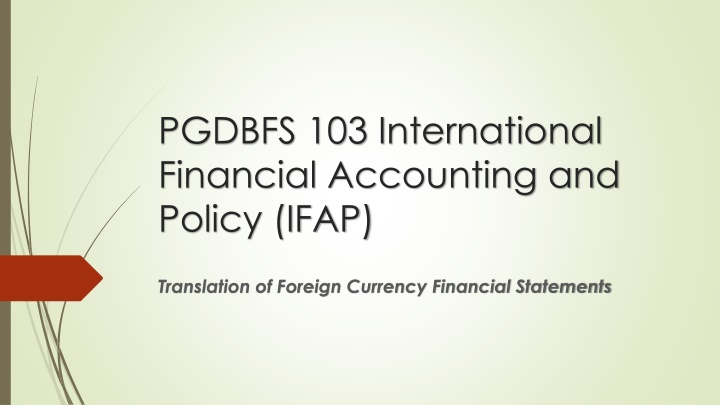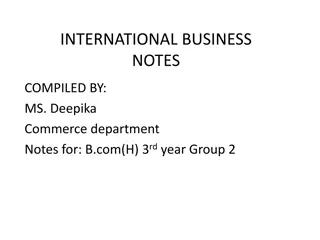International Financial Accounting and Policy (IFAP) Translation of Foreign Currency Financial Statements
Delve into the intricacies of translating foreign currency financial statements in the context of international financial accounting and policy. Explore the challenges and implications of this process, and gain insights into best practices for ensuring accurate and compliant reporting.
Download Presentation

Please find below an Image/Link to download the presentation.
The content on the website is provided AS IS for your information and personal use only. It may not be sold, licensed, or shared on other websites without obtaining consent from the author.If you encounter any issues during the download, it is possible that the publisher has removed the file from their server.
You are allowed to download the files provided on this website for personal or commercial use, subject to the condition that they are used lawfully. All files are the property of their respective owners.
The content on the website is provided AS IS for your information and personal use only. It may not be sold, licensed, or shared on other websites without obtaining consent from the author.
E N D
Presentation Transcript
PGDBFS 103 International Financial Accounting and Policy (IFAP) Translation of Foreign Currency Financial Statements
Foreign currency financial statements In today s global business environment, many companies have operations in foreign countries. To prepare group/consolidated financial statements parent companies must translate the financial statements of the foreign subsidiaries to the currency of the parent company. Functional and presentational currency Presentation currency is the currency a company has chosen to present its financial statements. This is a choice of the management Could differ from the functional currency Functional currency is the currency of the primary economic environment in which the entity operates. Primary economic environment is normally the economic environment in which the entity primarily generates income and expends cash.
Functional and presentational currency (continued) IAS 21 The effect of changes in foreign exchange rates requires each individual entity to determine its functional currency and measure its results and financial position in that currency. There are primary and secondary indicators to determine functional currency. Primary indicators of functional currency Indicators Factors to be considered by the entity in determining the functional currency Sales and cash inflows (a) The currency that mainly influences sales prices for its goods and services. This will often be the currency in which sales prices for goods and services are denominated and settled. Expenses and cash outflows The currency that mainly influences labour, material and other costs of providing goods and services. This is often the currency in which such costs are denominated and settled.
Functional and presentational currency (continued) Secondary indicators of functional currency Indicators Factors to be considered by the entity in determining the functional currency The currency in which funds from financing activities (such as issuing debt and equity instruments) are generated. Financing activities Retention of operating income The currency in which receipts from operating activities are usually retained. This is the currency in which the entity maintains its working capital balance. The primary and secondary indicators for determining the functional currency must be considered by all entities.
Translation of foreign currency financial statements If the presentation currency differs from the functional currency, the financial statements are retranslated into the presentation currency. According to the requirements contained in IAS 21 The effect of changes in foreign exchange rates: Assets and liabilities - translated at the closing exchange rate at the balance sheet date. Income and expenses - translated at exchange rates at the transaction dates. For practical reasons, an average rate for the relevant period is often used. All resulting exchange differences are accumulated as a separate component of equity. This separate component of equity is often referred to as cumulative translation adjustment (CTA).























